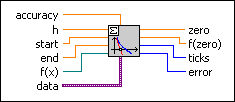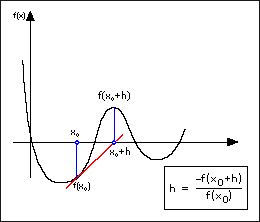 |
accuracy controls the accuracy of the zero determination. The default is 1.00E-8, which specifies the maximum deviation of the calculated solution from the actual solution.
|
 |
h is the delta value to calculate the derivative of the given formula. The default is 1E-8.
|
 |
start is the start point of the interval. The default is 0.0.
|
 |
end is the end point of the interval. The default is 1.0.
|
 |
formula is a string representing the function under investigation. The formula can contain any number of valid variables.
|
 |
zero is the determined zero of formula. zero is a good approximation only for the exact value.
|
 |
f(zero) is the function value at the point given by zero. The answer should be very close to zero.
|
 |
ticks is the time effort for the whole calculation of the function values in milliseconds.
|
 |
error returns any error or warning from the VI. You can wire error to the Error Cluster From Error Code VI to convert the error code or warning into an error cluster.
|
 |
accuracy controls the accuracy of the zero determination. The default is 1.00E-8, which specifies the maximum deviation of the calculated solution from the actual solution.
|
 |
h is the delta value to calculate the derivative of the given formula. The default is 1E-8.
|
 |
start is the start point of the interval. The default is 0.0.
|
 |
end is the end point of the interval. The default is 1.0.
|
 |
f(x) is a strictly typed reference to the VI that implements the 1D function. Create this VI by starting from the VI template located in labview\vi.lib\gmath\zero.llb\Zero Finder f(x) 1D.vit.
 Open template Open template
|
 |
data contains arbitrary values that pass to the VI that implements the function.
|
 |
zero is the determined zero of f(x). zero is a good approximation for only the exact value.
|
 |
f(zero) is the function value at the point given by zero. The answer should be very close to zero.
|
 |
ticks is the time effort for the whole calculation of the function values in milliseconds.
|
 |
error returns any error or warning from the VI. You can wire error to the Error Cluster From Error Code VI to convert the error code or warning into an error cluster.
|
The following illustration demonstrates the Newton strategy.
 Add to the block diagram
Add to the block diagram Find on the palette
Find on the palette











